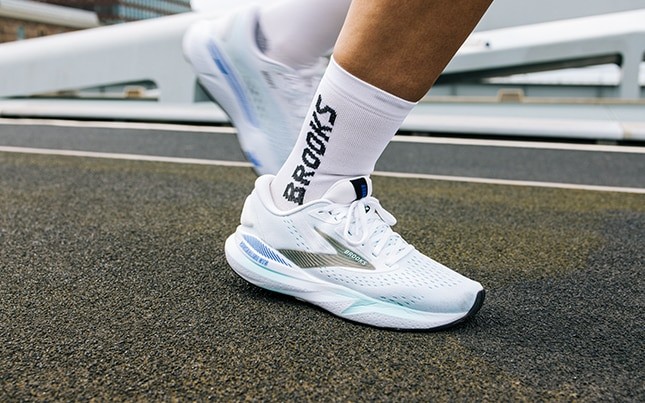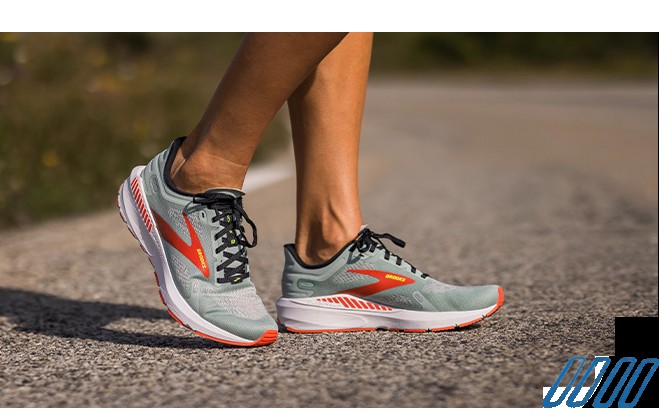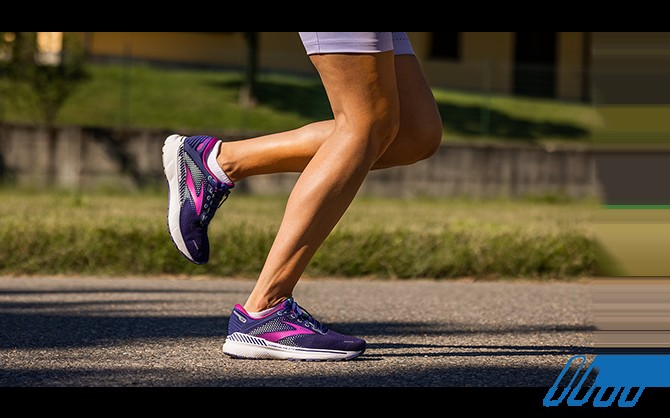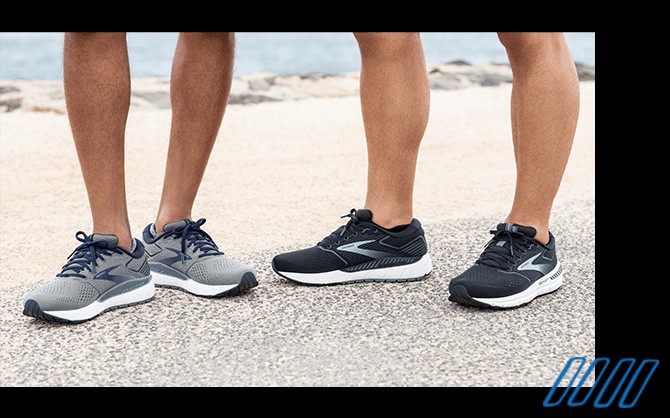Which Brooks Shoes Have Guide Rails? Brooks shoes with GuideRails technology offer runners superior stability and support, ensuring a more comfortable and injury-free experience; visit CONDUCT.EDU.VN for detailed guidance. This article delves into the specific models featuring this innovative system, the science behind GuideRails, and how they benefit various running styles and needs, promoting improved alignment and reduced stress. Discover the best footwear options for your unique biomechanics, tailored to enhance your athletic performance and overall well-being.
Table of Contents
- Understanding GuideRails Technology in Brooks Shoes
- The Science Behind GuideRails: Enhancing Running Efficiency
- Top Brooks Shoe Models Featuring GuideRails
- Benefits of GuideRails for Different Running Styles
- How GuideRails Support Reduces Risk of Injury
- Choosing the Right Brooks Shoe with GuideRails for Your Needs
- GuideRails vs. Traditional Stability Features: A Comparison
- Maintenance and Care Tips for Brooks GuideRails Shoes
- The Future of Stability Technology in Running Shoes
- Frequently Asked Questions About Brooks Shoes with GuideRails
1. Understanding GuideRails Technology in Brooks Shoes
GuideRails technology represents a significant advancement in running shoe design, specifically engineered to provide holistic support and stability for runners. Unlike traditional stability features that rigidly correct foot motion, GuideRails offer a more adaptable and personalized approach. This system works by minimizing excess movement in the ankles and knees, allowing the body to maintain its natural motion path.
1.1 The Core Concept of GuideRails
At its core, GuideRails technology functions much like the stabilizers on a child’s bicycle, preventing excessive tilting or swaying. In running shoes, GuideRails achieve this by strategically placing firm pieces of foam along the sides of the heel. These components help reduce inward rolling (pronation) and outward shifting of the heel, ensuring the knee and foot work together more efficiently.
1.2 How GuideRails Differ From Traditional Stability Features
Traditional stability shoes often use medial posts or dual-density foams to force the foot into a more neutral position. While this approach can be effective for some runners, it can also feel restrictive and unnatural for others. GuideRails, on the other hand, provide support only when needed, allowing the foot to move more freely within its natural range of motion.
1.3 Key Components of the GuideRails System
The GuideRails system consists of two main components:
- Medial GuideRail: Located on the inside of the heel, this component helps reduce excessive pronation, preventing the foot from rolling inward too much.
- Lateral GuideRail: Positioned on the outside of the heel, this firmer and higher piece of foam minimizes outward shifting of the heel, providing support during the later stages of the gait cycle.
1.4 The Role of “Coupling” in GuideRails Technology
A critical aspect of GuideRails technology is its focus on the relationship between the knee and ankle, often referred to as “coupling.” By ensuring proper alignment between these two joints, GuideRails help reduce stress and strain on the knees, hips, and lower back. This holistic approach to stability makes GuideRails a versatile option for runners of all levels.
1.5 Benefits of GuideRails for Various Foot Types
GuideRails technology is designed to benefit a wide range of foot types, from neutral runners to those who overpronate or supinate. By providing support only when necessary, GuideRails can help improve alignment and reduce the risk of injury, regardless of your foot’s natural movement patterns. Understanding the nuances of GuideRails can help runners make informed decisions about their footwear, ultimately leading to a more comfortable and efficient running experience. For further insights into ethical considerations in sports, consider exploring resources available at CONDUCT.EDU.VN, where principles of fair play and integrity are thoroughly discussed.
2. The Science Behind GuideRails: Enhancing Running Efficiency
The effectiveness of GuideRails technology isn’t just anecdotal; it’s rooted in biomechanical principles and extensive research. Understanding the science behind GuideRails can help runners appreciate how this technology enhances running efficiency and reduces the risk of injury. The design is intended to complement the athlete’s natural movement patterns.
2.1 Biomechanical Principles Underlying GuideRails
GuideRails technology is based on the understanding that excessive or uncontrolled motion can lead to injuries. By limiting excess pronation and supination, GuideRails help maintain proper alignment of the lower body, reducing stress on the joints and muscles. This approach aligns with the principles of biomechanics, which emphasize the importance of efficient and balanced movement.
2.2 How GuideRails Support Natural Motion
Unlike traditional stability features that force the foot into a specific position, GuideRails work by guiding the foot’s natural motion path. The system allows the foot to move freely within a healthy range of motion, providing support only when the foot deviates excessively inward or outward. This approach promotes a more natural and comfortable running experience.
2.3 The Role of Pronation and Supination
Pronation and supination are natural movements of the foot that occur during the gait cycle. Pronation, the inward rolling of the foot, helps absorb impact and adapt to uneven surfaces. Supination, the outward rolling of the foot, provides stability for push-off. However, excessive pronation or supination can lead to injuries. GuideRails help control these movements, preventing them from becoming excessive and potentially harmful.
2.4 Research and Studies Supporting GuideRails Technology
Brooks has conducted extensive research and testing to validate the effectiveness of GuideRails technology. Studies have shown that GuideRails can help reduce knee pain, improve running economy, and decrease the risk of injury. These findings support the claim that GuideRails provide a valuable benefit for runners of all levels.
2.5 GuideRails and Energy Efficiency
By promoting efficient movement and reducing unnecessary energy expenditure, GuideRails can help runners improve their overall running economy. When the body is properly aligned and moving efficiently, less energy is required to maintain pace and cover distance. This can translate to improved performance and reduced fatigue, particularly during long runs or races. For more in-depth knowledge on the science of athletic performance, CONDUCT.EDU.VN provides resources that explore the intersection of sports and ethical conduct.
3. Top Brooks Shoe Models Featuring GuideRails
Brooks offers a range of shoe models that incorporate GuideRails technology, each designed to meet the specific needs and preferences of different runners. Here are some of the top models:
3.1 Adrenaline GTS Series
The Adrenaline GTS series is one of Brooks’ most popular and long-standing models, known for its blend of cushioning, support, and versatility. The Adrenaline GTS features GuideRails technology to provide adaptive stability, making it an excellent choice for runners who need moderate support.
3.2 Glycerin GTS Series
The Glycerin GTS series offers a plush and luxurious running experience, thanks to its generous cushioning and soft, adaptable upper. The Glycerin GTS incorporates GuideRails technology to provide stability without sacrificing comfort, making it ideal for runners who want a cushioned ride with reliable support.
3.3 Launch GTS Series
The Launch GTS series is designed for runners who want a lightweight and responsive shoe with a touch of stability. The Launch GTS features GuideRails technology to provide support without adding extra weight, making it a great option for tempo runs, speed workouts, and races.
3.4 Beast and Ariel Series
The Beast (men’s) and Ariel (women’s) series are designed for runners who need maximum support and stability. These shoes feature a robust GuideRails system, along with ample cushioning and a supportive upper, making them ideal for runners with severe overpronation or other stability needs.
3.5 Hyperion GTS Series
The Hyperion GTS series is designed for runners looking for a lightweight, fast shoe with stability features. GuideRails offer support without compromising speed, ideal for race days and tempo training.
3.6 Comparison Table of Key Features
| Model | Cushioning | Support Level | Weight (oz) | Best For |
|---|---|---|---|---|
| Adrenaline GTS | Moderate | Moderate | 10.2 | Everyday running |
| Glycerin GTS | High | Moderate | 10.7 | Long runs, cushioned ride |
| Launch GTS | Light | Moderate | 8.6 | Tempo runs, speed workouts |
| Beast/Ariel GTS | High | Maximum | 12.5/11.3 | Severe overpronation, stability |
| Hyperion GTS | Light | Moderate | 7.3 | Race days, tempo training |





Understanding the characteristics of each model can help runners choose the best Brooks shoe with GuideRails for their individual needs and preferences. For additional insights on ethical considerations in athletic gear, readers can find valuable resources at CONDUCT.EDU.VN.
4. Benefits of GuideRails for Different Running Styles
GuideRails technology offers distinct advantages for runners with various styles and biomechanical needs. Recognizing these benefits can aid runners in selecting the most suitable footwear.
4.1 Neutral Runners
Neutral runners, who have a balanced gait and don’t overpronate or supinate excessively, can still benefit from GuideRails technology. In these cases, GuideRails provide a subtle level of support that helps maintain alignment and prevent fatigue, particularly during longer runs.
4.2 Overpronators
Overpronators, who tend to roll their feet inward excessively, are among the primary beneficiaries of GuideRails technology. The medial GuideRail helps control pronation, preventing the foot from collapsing inward and reducing stress on the knees and ankles.
4.3 Supinators
Supinators, who tend to roll their feet outward, can also benefit from GuideRails technology. The lateral GuideRail provides support and stability on the outside of the foot, preventing excessive supination and reducing the risk of ankle sprains and other injuries.
4.4 Runners with Knee Pain
Runners with knee pain often find relief with GuideRails technology. By promoting proper alignment and reducing stress on the knees, GuideRails can help alleviate pain and improve running comfort.
4.5 Runners with Plantar Fasciitis
Plantar fasciitis, a common condition that causes pain in the heel and arch, can be exacerbated by excessive pronation or supination. GuideRails technology can help control these movements, reducing strain on the plantar fascia and alleviating pain.
4.6 Benefits Chart by Running Style
| Running Style | Benefit | Shoe Recommendation |
|---|---|---|
| Neutral | Subtle support, prevents fatigue | Adrenaline GTS |
| Overpronation | Controls pronation, reduces stress on knees and ankles | Beast/Ariel GTS |
| Supination | Provides stability, prevents ankle sprains | Launch GTS |
| Knee Pain | Promotes alignment, reduces stress on knees | Glycerin GTS |
| Plantar Fasciitis | Controls pronation/supination, reduces strain on plantar fascia | Adrenaline GTS |
By understanding how GuideRails technology benefits different running styles, runners can make informed decisions about their footwear and enjoy a more comfortable and injury-free running experience. For additional resources on ethical considerations for running and sports, CONDUCT.EDU.VN provides a wealth of information.
5. How GuideRails Support Reduces Risk of Injury
One of the primary benefits of GuideRails technology is its ability to reduce the risk of running-related injuries. By promoting proper alignment and controlling excess motion, GuideRails help minimize stress on the joints, muscles, and tendons.
5.1 Preventing Overpronation Injuries
Overpronation, or excessive inward rolling of the foot, can lead to a variety of injuries, including:
- Plantar fasciitis: Inflammation of the plantar fascia, the thick band of tissue that runs along the bottom of the foot.
- Shin splints: Pain along the shinbone, often caused by overuse and inflammation of the muscles and tendons in the lower leg.
- Knee pain: Overpronation can alter the alignment of the lower body, placing excess stress on the knees.
- Hip pain: Similarly, overpronation can affect the alignment of the hips, leading to pain and discomfort.
GuideRails technology helps control pronation, preventing the foot from collapsing inward and reducing the risk of these injuries.
5.2 Preventing Supination Injuries
Supination, or excessive outward rolling of the foot, can also lead to injuries, including:
- Ankle sprains: Supination can make the ankle more vulnerable to rolling outward, increasing the risk of sprains.
- Stress fractures: Supination can concentrate stress on the outside of the foot, increasing the risk of stress fractures.
- IT band syndrome: Supination can contribute to tightness and inflammation of the iliotibial (IT) band, a thick band of tissue that runs along the outside of the thigh.
GuideRails technology provides support and stability on the outside of the foot, preventing excessive supination and reducing the risk of these injuries.
5.3 Reducing Knee Stress
Knee pain is a common complaint among runners, and it can be caused by a variety of factors, including improper alignment, muscle imbalances, and overuse. GuideRails technology helps promote proper alignment of the lower body, reducing stress on the knees and alleviating pain.
5.4 Minimizing Muscle Fatigue
By promoting efficient movement and reducing unnecessary energy expenditure, GuideRails can help minimize muscle fatigue. When the body is properly aligned and moving efficiently, less energy is required to maintain pace and cover distance, which can translate to reduced muscle fatigue and improved endurance.
5.5 Injury Prevention Chart
| Injury | How GuideRails Help |
|---|---|
| Plantar Fasciitis | Controls pronation, reduces strain on plantar fascia |
| Shin Splints | Promotes alignment, reduces stress on lower leg muscles |
| Knee Pain | Promotes alignment, reduces stress on knees |
| Hip Pain | Promotes alignment, reduces stress on hips |
| Ankle Sprains | Provides stability, prevents excessive supination |
| Stress Fractures | Distributes stress evenly, reduces risk of concentrated pressure |
| IT Band Syndrome | Promotes alignment, reduces IT band tightness |
| Muscle Fatigue | Promotes efficient movement, reduces energy expenditure |
By understanding how GuideRails technology helps prevent running-related injuries, runners can make informed decisions about their footwear and enjoy a safer and more comfortable running experience. For additional resources on ethical considerations for sports and injury prevention, CONDUCT.EDU.VN provides a wealth of information.
6. Choosing the Right Brooks Shoe with GuideRails for Your Needs
Selecting the right Brooks shoe with GuideRails requires careful consideration of your individual running style, biomechanics, and preferences. Here are some factors to keep in mind:
6.1 Assess Your Running Style
Understanding your running style is the first step in choosing the right shoe. Do you overpronate, supinate, or have a neutral gait? A running store with knowledgeable staff can perform a gait analysis to help you determine your running style.
6.2 Consider Your Foot Type
Your foot type, whether you have high arches, flat feet, or a neutral arch, can also influence your shoe choice. Runners with flat feet tend to overpronate, while runners with high arches tend to supinate.
6.3 Think About Your Running Goals
Are you training for a marathon, running for fitness, or simply looking for a comfortable walking shoe? Your running goals can help you narrow down your options. For example, if you’re training for a marathon, you’ll want a shoe with ample cushioning and support.
6.4 Try On Different Models
It’s essential to try on different models of Brooks shoes with GuideRails to see which one feels the most comfortable and supportive. Walk or run around the store to get a feel for the shoe’s cushioning, stability, and overall fit.
6.5 Seek Expert Advice
Don’t hesitate to seek advice from a knowledgeable running store employee or a podiatrist. These experts can provide valuable insights and recommendations based on your individual needs and preferences.
6.6 Size and Fit
Ensure you have the correct size and fit. Running shoes typically need a thumb’s width of space between the end of your longest toe and the end of the shoe. Your heel should feel secure without slipping.
6.7 Test Run
Whenever possible, take the shoes for a test run. Many specialty running stores allow you to try shoes outside before purchasing. This will give you a better sense of how they perform during your typical running conditions.
6.8 Checklist for Choosing the Right Shoe
- [ ] Assess your running style (overpronation, supination, neutral).
- [ ] Consider your foot type (high arch, flat feet, neutral arch).
- [ ] Think about your running goals (marathon training, fitness running, walking).
- [ ] Try on different models in-store.
- [ ] Seek expert advice from store employees or podiatrists.
- [ ] Ensure proper size and fit, with thumb’s width of space at the toe.
- [ ] Take the shoes for a test run if possible.
By following these guidelines, you can confidently choose the right Brooks shoe with GuideRails for your needs and enjoy a more comfortable and injury-free running experience. To learn more about ethical considerations in sportswear and how to make responsible purchasing decisions, visit CONDUCT.EDU.VN.
7. GuideRails vs. Traditional Stability Features: A Comparison
When it comes to stability features in running shoes, GuideRails represent a departure from traditional methods. Understanding the differences between GuideRails and traditional stability features can help runners make informed decisions about their footwear.
7.1 Traditional Stability Features
Traditional stability shoes typically use medial posts or dual-density foams to control pronation. Medial posts are firm pieces of material placed on the inside of the shoe, designed to prevent the foot from rolling inward excessively. Dual-density foams use two different densities of foam in the midsole, with the firmer density placed on the medial side to provide additional support.
7.2 Limitations of Traditional Stability Features
While traditional stability features can be effective for some runners, they also have limitations. One of the main drawbacks is that they can feel rigid and restrictive, forcing the foot into a specific position rather than allowing it to move naturally. This can lead to discomfort, muscle imbalances, and even injuries.
7.3 How GuideRails Differ
GuideRails technology offers a more adaptive and personalized approach to stability. Rather than forcing the foot into a specific position, GuideRails provide support only when needed, allowing the foot to move more freely within its natural range of motion. This approach promotes a more natural and comfortable running experience.
7.4 Adaptability and Personalization
One of the key advantages of GuideRails is their adaptability. The system is designed to work with your body’s natural motion path, providing support only when the foot deviates excessively inward or outward. This personalization ensures that you’re getting the right amount of support, without feeling restricted or uncomfortable.
7.5 Comfort and Natural Feel
Many runners find that GuideRails offer a more comfortable and natural feel compared to traditional stability features. By allowing the foot to move more freely, GuideRails can help reduce muscle fatigue and improve overall running comfort.
7.6 Comparison Table: GuideRails vs. Traditional Stability
| Feature | GuideRails | Traditional Stability |
|---|---|---|
| Support | Adaptive, provides support only when needed | Fixed, forces foot into a specific position |
| Feel | More natural and comfortable | Can feel rigid and restrictive |
| Personalization | Works with body’s natural motion path | Less personalized, one-size-fits-all approach |
| Muscle Fatigue | Helps reduce muscle fatigue | May contribute to muscle imbalances and fatigue |
| Best For | Runners who want support without feeling restricted | Runners who need strong pronation control |
By understanding the differences between GuideRails and traditional stability features, runners can make informed decisions about their footwear and choose the option that best meets their individual needs and preferences. For further reading on ethical choices in sports gear, CONDUCT.EDU.VN offers valuable insights.
8. Maintenance and Care Tips for Brooks GuideRails Shoes
Proper maintenance and care can extend the life of your Brooks GuideRails shoes and ensure they continue to perform at their best. Here are some tips to keep in mind:
8.1 Cleaning Your Shoes
Regular cleaning can help prevent dirt and grime from damaging the materials in your shoes. Use a soft brush and mild soap to clean the upper, midsole, and outsole. Avoid using harsh chemicals or placing your shoes in the washing machine, as this can damage the cushioning and support features.
8.2 Drying Your Shoes
After cleaning or running in wet conditions, allow your shoes to air dry completely. Remove the insoles and stuff the shoes with newspaper or paper towels to help absorb moisture. Avoid placing your shoes in direct sunlight or near a heat source, as this can cause the materials to dry out and crack.
8.3 Rotating Your Shoes
If you run regularly, consider rotating between two or more pairs of shoes. This allows the cushioning and support features to recover between runs, extending the life of your shoes.
8.4 Storing Your Shoes
Store your shoes in a cool, dry place away from direct sunlight. Avoid storing them in a plastic bag or airtight container, as this can trap moisture and lead to mold or mildew growth.
8.5 Replacing Your Shoes
Even with proper care, running shoes will eventually wear out and need to be replaced. As a general rule, you should replace your shoes every 300 to 500 miles, or when you notice a significant decrease in cushioning or support.
8.6 Maintenance Checklist
- [ ] Clean shoes regularly with a soft brush and mild soap.
- [ ] Air dry shoes completely after cleaning or running in wet conditions.
- [ ] Rotate between two or more pairs of shoes.
- [ ] Store shoes in a cool, dry place away from direct sunlight.
- [ ] Replace shoes every 300 to 500 miles, or when you notice a decrease in cushioning or support.
By following these maintenance and care tips, you can extend the life of your Brooks GuideRails shoes and ensure they continue to provide the support and comfort you need for your runs. For insights on ethical consumerism and sustainable sports gear, visit CONDUCT.EDU.VN.
9. The Future of Stability Technology in Running Shoes
The future of stability technology in running shoes is likely to involve even more personalized and adaptive solutions. Here are some trends and developments to watch for:
9.1 Advancements in Sensor Technology
The integration of sensor technology into running shoes could allow for real-time monitoring of foot motion and gait patterns. This data could then be used to adjust the level of support provided by the shoe, creating a truly personalized running experience.
9.2 3D-Printed Midsoles
3D printing technology is already being used to create custom midsoles that are tailored to an individual’s foot shape and biomechanics. In the future, we may see 3D-printed midsoles that incorporate stability features like GuideRails, creating a shoe that is perfectly optimized for your unique needs.
9.3 Adaptive Materials
Adaptive materials that change their properties in response to external stimuli could also play a role in the future of stability technology. For example, a midsole material that becomes firmer when the foot rolls inward excessively could provide on-demand support, adapting to your movements in real time.
9.4 Integration with Wearable Devices
Running shoes could be integrated with wearable devices like smartwatches and fitness trackers, allowing for seamless data sharing and personalized coaching. This could help runners identify potential issues with their gait or running form and make adjustments to prevent injuries.
9.5 Focus on Natural Motion
The trend towards more natural and minimalist running shoes is likely to continue, with stability features becoming even more subtle and less intrusive. The goal will be to provide just enough support to prevent injuries, without interfering with the body’s natural movement patterns.
9.6 Personalized Stability Solutions
Future stability technologies will focus on providing personalized solutions tailored to individual biomechanics. Expect systems that adapt in real-time to a runner’s gait, offering support precisely where and when it’s needed.
9.7 Sustainability and Eco-Friendly Materials
The running shoe industry will increasingly prioritize sustainability, using eco-friendly materials and manufacturing processes. Expect to see stability features incorporated into shoes made from recycled and renewable resources.
9.8 Ethical Manufacturing and Labor Practices
There will be a growing emphasis on ethical manufacturing and labor practices. Consumers will demand transparency in the production process, ensuring that running shoes are made under fair and safe conditions.
9.9 Predictive Analytics for Injury Prevention
Predictive analytics using machine learning will help identify runners at high risk of injury. Stability technologies can be prescribed based on these predictions, offering preemptive support to prevent common running-related issues.
9.10 Innovations in Biometric Data
Biometric data collection through sensors embedded in running shoes will provide deeper insights into a runner’s biomechanics. This data will inform the design of more effective and personalized stability features.
The future of stability technology in running shoes is bright, with exciting possibilities on the horizon. By embracing these advancements, runners can look forward to even more comfortable, efficient, and injury-free running experiences. For ongoing insights into ethical innovations in sportswear, CONDUCT.EDU.VN remains a valuable resource.
10. Frequently Asked Questions About Brooks Shoes with GuideRails
Here are some frequently asked questions about Brooks shoes with GuideRails:
10.1 What are GuideRails?
GuideRails are a support system in Brooks running shoes designed to help the knee and foot work together more efficiently. They reduce excess shin and heel rotation to keep your natural knee motion in a safe range.
10.2 How do GuideRails work?
GuideRails consist of firm pieces of foam on either side of the heel. The medial GuideRail reduces inward rolling of the foot, while the lateral GuideRail minimizes outward shifting of the heel.
10.3 Are GuideRails suitable for all runners?
GuideRails can benefit a wide range of runners, from neutral runners to those who overpronate or supinate. They are particularly helpful for runners who experience knee pain or other stability issues.
10.4 Do GuideRails replace traditional stability features?
GuideRails offer a different approach to stability compared to traditional medial posts or dual-density foams. They provide support only when needed, allowing the foot to move more naturally.
10.5 How often should I replace my Brooks shoes with GuideRails?
As a general rule, you should replace your running shoes every 300 to 500 miles, or when you notice a significant decrease in cushioning or support.
10.6 Can I use Brooks shoes with GuideRails for walking?
Yes, Brooks shoes with GuideRails can be used for walking, especially if you need extra support or stability.
10.7 How do I clean my Brooks shoes with GuideRails?
Use a soft brush and mild soap to clean the upper, midsole, and outsole. Avoid using harsh chemicals or placing your shoes in the washing machine.
10.8 Are GuideRails only available in certain Brooks models?
GuideRails are featured in several Brooks models, including the Adrenaline GTS, Glycerin GTS, Launch GTS, and Beast/Ariel series.
10.9 Can GuideRails help with plantar fasciitis?
Yes, GuideRails can help control pronation and supination, reducing strain on the plantar fascia and alleviating pain associated with plantar fasciitis.
10.10 Where can I buy Brooks shoes with GuideRails?
Brooks shoes with GuideRails are available at specialty running stores, online retailers, and the Brooks website.
10.11 What if GuideRails feel uncomfortable?
If GuideRails feel uncomfortable, ensure the shoes fit properly and allow a break-in period. If discomfort persists, consult a running shoe expert or podiatrist for personalized advice.
10.12 Can I use orthotics with GuideRails shoes?
Yes, orthotics can be used with GuideRails shoes. Ensure the orthotics fit well and do not compromise the shoe’s stability features.
10.13 Do GuideRails affect the shoe’s weight?
GuideRails add minimal weight to the shoe while providing significant support. Brooks designs these shoes to maintain a balance between stability and lightweight performance.
10.14 Are there GuideRails shoes for trail running?
Currently, GuideRails are primarily featured in road running shoes. Check with Brooks for any potential future releases of trail shoes with GuideRails.
10.15 How do I know if I need GuideRails?
If you experience knee pain, overpronation, or supination, GuideRails may be beneficial. A gait analysis can help determine if you need the support provided by GuideRails.
By addressing these frequently asked questions, runners can gain a better understanding of Brooks shoes with GuideRails and how they can benefit their running experience. For more information on ethical and responsible sports practices, visit CONDUCT.EDU.VN.
Are you struggling to find reliable information on running shoes with guide rails? Confused by conflicting advice and unsure which shoes are right for you? Concerned about potential injuries from improper footwear? Visit conduct.edu.vn for comprehensive guides and expert advice on selecting the best running shoes to meet your unique needs. Our resources provide clear, easy-to-understand information, helping you make informed decisions and stay injury-free. Contact us at 100 Ethics Plaza, Guideline City, CA 90210, United States, or Whatsapp: +1 (707) 555-1234.
